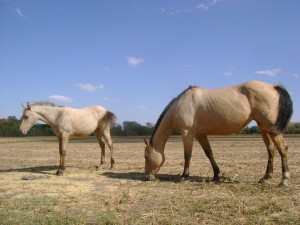 When you have a foal, everything is sweetness and light. But only for so long. Then the life lessons begin and they have to learn to wear a halter, to follow a leader, to stand tied, and face their biggest fear of all—being separated from their mommy. It is a difficult change for both mare and foal, to give up that comfort and connection. But weaning a foal helps develop the disposition a horse needs to have—a working horse has to be able to go out and do a job without throwing a fuss when it is separated from other horses. Weaning is a very important step in the life of a foal.
When you have a foal, everything is sweetness and light. But only for so long. Then the life lessons begin and they have to learn to wear a halter, to follow a leader, to stand tied, and face their biggest fear of all—being separated from their mommy. It is a difficult change for both mare and foal, to give up that comfort and connection. But weaning a foal helps develop the disposition a horse needs to have—a working horse has to be able to go out and do a job without throwing a fuss when it is separated from other horses. Weaning is a very important step in the life of a foal.
Why wean a foal? I have heard of people leaving the baby with the mother indefinitely, or letting the mare gradually wean the foal herself. This might work, if you have no plan at all. For instance, if you aren’t planning on rebreeding the mare, or riding the mare, or training the foal, or ever separating them their entire lives, then that method would work. But then you might as well pin a label on your lapel that says “Backyard Breeder” or “Shabby Horse Owner”. If your mare is rebred, she needs the nutrients to build the baby inside her, and with winter coming on, you need to boost her intake even more by weaning the foal. And the foal needs to learn to do without the mother and to bond with a human handler enough to lead obediently and stand tied apart from other horses when necessary.
When should you wean a foal? There are varying opinions on this, but most sources say that six months old is a good time to wean. Some prefer to leave the foal on longer, and if the mare is not rebred, then there is no hurry—eight months to a year is fine. I have heard of owners who wean the foal early if the mare has undesirable traits that they don’t want the foal to pick up. We had a mare that always pawed at her feed pan and tipped all the grain out on the ground. Every one of her foals was the same way their entire lives. But there are worse problems than a messy eater, and if your mare displays a bad attitude or spookiness that you don’t want your foal to possess, you can wean the foal as soon as it is able to eat enough solid food to grow and thrive. But weaning before the age of six months may create other problems in the foal (extreme insecurity, unecessary stress-related behaviours such as chewing, cribbing, etc.), so try to do whatever is best for the foal.
What is the best way to wean a foal? As with anything, you have to work with what you have, as far as your corral or pasture set-up. Our veterinarian told us that taking the mare away completely out of sight and hearing of the foal, and putting the foal with a trusted companion horse or group of other foals is the easiest way. It is actually more stressful to them both to separate them for only a certain time period each day, or to separate them but allow them to still see each other. I have heard of foals being weaned, but when the owner put them back together after the mare was dried up, the foal still nursed regularly, even though it was receiving no milk. This is a sign of a foal that has been weaned too early, and then put back with its mother too soon. Our farm doesn’t have the space necessary to put the mother completely out of sight, so we are planning to keep the foal with our gelding Milo in a safe, smaller pen next to the mare’s until the edge of the foal’s neediness wears off, and then move the mare in with our other two mares.
Our stud colt is already wanting to befriend our other horses, which is a good sign that he is ready to form other friendships. He is also very curious and people-friendly, so the weaning stage is a great time to develop his acceptance of being handled and led without his mother’s presence. We plan on spending a lot of time with him and getting him to let us work with his feet and stand tied. His natural curiosity makes it easier to work with him than a foal that is frightened, because he welcomes new things and is so interested in what you are doing. He will be a quick learner, I think.
What else should you work on while weaning a foal? A few more tips and ideas include feeding the foal appropriately while he is being weaned—he will need more grain than he has been eating previously, and a constant supply of hay will help keep him occupied and not missing his mother so badly. This is a great time to deworm a weanling, so if you haven’t done this recently, make sure he is dewormed. Work on all stages of catching, haltering, leading, tying, and getting used to being handled. This is a great time to give the colt a solid foundation in groundwork and manners, and the more time you spend bonding with the foal, the less time he will have to miss his mother. You can also introduce the horse trailer to the foal as soon as he is leading well, and this article will give you some good advice on trailer loading.


{ 1 comment }
Great advice… and I look forward to watching you wean your cute little guy!